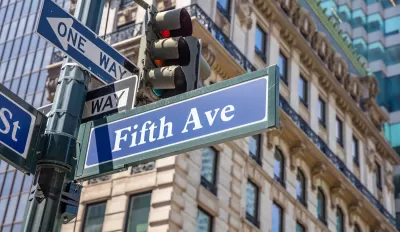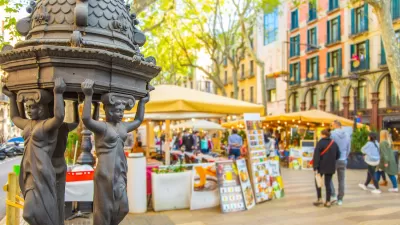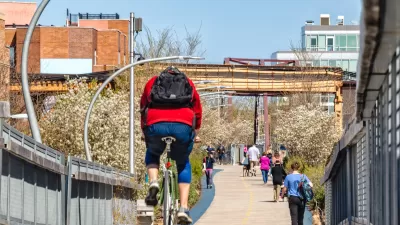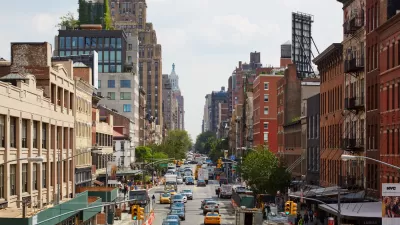Visitors to the iconic shopping street overwhelmingly arrive by walking, transit, or bike. Why are bike and pedestrian infrastructure improvement lagging so far behind another famous NYC street, Broadway?

Writing in Streetsblog NYC, Barak Friedman, Paul Krikler, and Janet Liff compare the adaptations of two iconic New York City streets to 21st century conditions: “while Broadway continues to transform into a world class destination, becoming more pedestrian and bike friendly, Fifth Avenue struggles.”
While Broadway is becoming increasingly pedestrianized and bike-friendly, Fifth Avenue languishes as e-commerce and commercial real estate vacancies leave the fabled shopping street emptier and emptier. According to the authors, former Mayor Bill de Blasio’s devision to nix a ‘compelte street’ plan for Fifth Avenue in 2021 “is sabotaging business interests and hurting the larger midtown post-pandemic recovery.”
A recent survey shows that crowded sidewalks make visitors to Fifth Avenue less likely to linger and shop. The same survey reveals that “Of the 226 people surveyed on Fifth Avenue, only 3 percent of people (seven people total) reached Fifth Avenue by using a private car or ride share. Some 97 percent of people walked, used public transit, or cycled.” And “Almost 70 percent of respondents indicated that they would be “more inclined” to cycle on Fifth Avenue with the addition of a protected bike lane.”
The authors conclude that in this case, more than others, “the interests of safety activists, the interests of business stakeholders, and the greater benefit to New York City are aligned.” Improved bike and pedestrian infrastructure on Fifth Avenue would benefit visitors, businesses, and Midtown Manhattan as a whole.
FULL STORY: Two Paths Forward: Broadway Shows What Could Be on Fifth Avenue

Planetizen Federal Action Tracker
A weekly monitor of how Trump’s orders and actions are impacting planners and planning in America.

Maui's Vacation Rental Debate Turns Ugly
Verbal attacks, misinformation campaigns and fistfights plague a high-stakes debate to convert thousands of vacation rentals into long-term housing.

Restaurant Patios Were a Pandemic Win — Why Were They so Hard to Keep?
Social distancing requirements and changes in travel patterns prompted cities to pilot new uses for street and sidewalk space. Then it got complicated.

In California Battle of Housing vs. Environment, Housing Just Won
A new state law significantly limits the power of CEQA, an environmental review law that served as a powerful tool for blocking new development.

Boulder Eliminates Parking Minimums Citywide
Officials estimate the cost of building a single underground parking space at up to $100,000.

Orange County, Florida Adopts Largest US “Sprawl Repair” Code
The ‘Orange Code’ seeks to rectify decades of sprawl-inducing, car-oriented development.
Urban Design for Planners 1: Software Tools
This six-course series explores essential urban design concepts using open source software and equips planners with the tools they need to participate fully in the urban design process.
Planning for Universal Design
Learn the tools for implementing Universal Design in planning regulations.
Heyer Gruel & Associates PA
JM Goldson LLC
Custer County Colorado
City of Camden Redevelopment Agency
City of Astoria
Transportation Research & Education Center (TREC) at Portland State University
Jefferson Parish Government
Camden Redevelopment Agency
City of Claremont





























